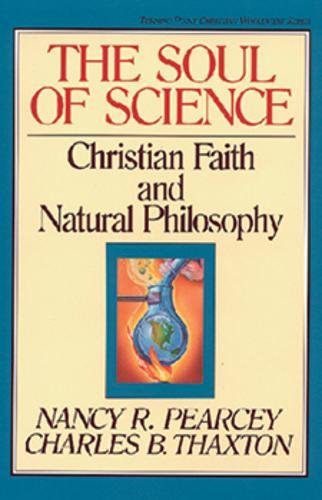A Brief Book Summary from Books At A Glance
By Joshua K. Smith
Overview
In The Soul of Science, Nancy Pearcey and Charles Thaxton recall and re-examine the Christian heritage and ideology that motivated a scientific revolution. This work introduces the reader to the history of science and the often-neglected discussions about the religious ideology behind scientific developments. The authors handled this endeavor with great care and precision, tracing each development in scientific thought and the implications as they bring to bear on the modern discipline of science.
Outline
Introduction
Part One: The New History of Science
1. An Invented Institution: Christianity and the Scientific Revolution
2. The History of Science and the Science of History: Contemporary Approaches and their Intellectual Roots
Part Two: The First Scientific Revolution
3. A New “Thinking Cap”: Three Little Sciences and How They Grew
4. The Newtonian World Machine: How Does God Relate to the World?
5. The Belated Revolution in Biology: Taking Biology from Metaphysics
Part Three: The Rise and Fall of Mathematics
6. Math in the Past: Discovering the Structure of Creation
7. The Idol Falls: Non-Euclidean Geometry and the Revolution in Mathematics
Part Four: The Second Scientific Revolution
8. Is Everything Relative?: The Revolution in Physics
9. Quantum Mysteries: Making Sense of the New Physics
10. A Chemical Code: Resolving Historical Controversies
Book Summary
Introduction
What were the presuppositions and beliefs behind the great scientist and philosophical minds during the scientific revolutions? Pearcey and Thaxton seek to reintroduce the Christian foundations in the development of prevailing scientific thought that arose in Western Europe, especially between 1500–1800’s.
Part One: The New History of Science
Chapter One: An Invented Institution: Christianity and the Scientific Revolution
Many assume that the subject of science beings in a vacuum, void of religion or presupposition. However, this view ignores the genuine friendship that existed between faith and the development of the sciences, as known today, during the middle ages. Pierre Duhem (1861–1916), a French philosopher and physicist discovered that many thirteenth-century scientists, working in a Christianized Europe, actually laid the foundations to the entire scientific endeavor. This may come as a surprise since many depictions of the relations of science and faith are under a warfare thesis, mostly associated with the scientist and scholar Thomas Huxley.
Even though medieval Europe was not the most advanced or sophisticated culture (cf. Chinese and Arabs production of higher learning), it produces a systematized discipline in the sciences, why? According to the authors, it is directly related to their view of God. Their faith drove their curiosity and provided the fabric in which they could weave the threads of theology, science, and philosophy together. The laws and governance of this world where controlled by a good God and this truth pushed those such as J. Kepler (1571–1630) to strive for an alternative explanation to circular orbits (see elliptical orbits).
Likewise, Thomas Aquinas (1225–1274), adapting Aristotelian philosophy, incorporated his faith into his scientific investigations which later become known as Scholasticism. But that is not to say there was no tension at times. For the acceptance of some Aristotelian ideas (e.g., circular motion) were condemned in 1277, eventually leading to further theological and philosophical developments (see Voluntarism) under an empirical eye. More to this, the opposition to scientific thought from the church was due to theological concerns. For example, the famous Galileo controversy has more to do with a concern for a detachment from Aristotelian philosophy and metaphysics (i.e., social and moral consequences). Meaning, it was not necessarily Galileo’s view of science that was the issue, but his rejection of Aristotle. Faith and presumption cannot be divorced from one’s scientific investigations and conclusions.
Chapter Two: The History of Science and the Science of History: Contemporary Approaches and Their Intellectual Roots
How does the historiography of science help modernity better understand the agenda behind the scientific revolution? Until publications of Frances Yates and Charles Webster, this question was not considered by historians. This new approach helped unearth the philosophical ideas behind the prominent scientific figures of the scientific revolution. In the approach to the history of science, there are two primary (broadly speaking) camps––positivist and idealist. The positivist approach sought to unveil the dangers of religious belief in scientific endeavors, using the Middle Ages and its blemishes as a proof-text. Voltaire (1694–1778), Marquis de Condorcet (1743–1794), and Auguste Comte (1798–1857) wielded this approach in the formulation of ideas. But what exactly is positivism? Essentially, it means that every contention or belief should be provable through verification by mathematics and logic (minus metaphysics and theism).
On the Idealist side, there was an effort to unify scientific language and method (i.e., Natural Sciences). Working of Hegelian ideas (difference in Nature and Mind), the natural sciences were separated from history, which consisted of what modernity labels the humanities: religion, ethics, literature, art, etc. The idea here is that the natural sciences require a distinct. . .
[To continue reading this summary, please see below....]The remainder of this article is premium content. Become a member to continue reading.
Already have an account? Sign In
